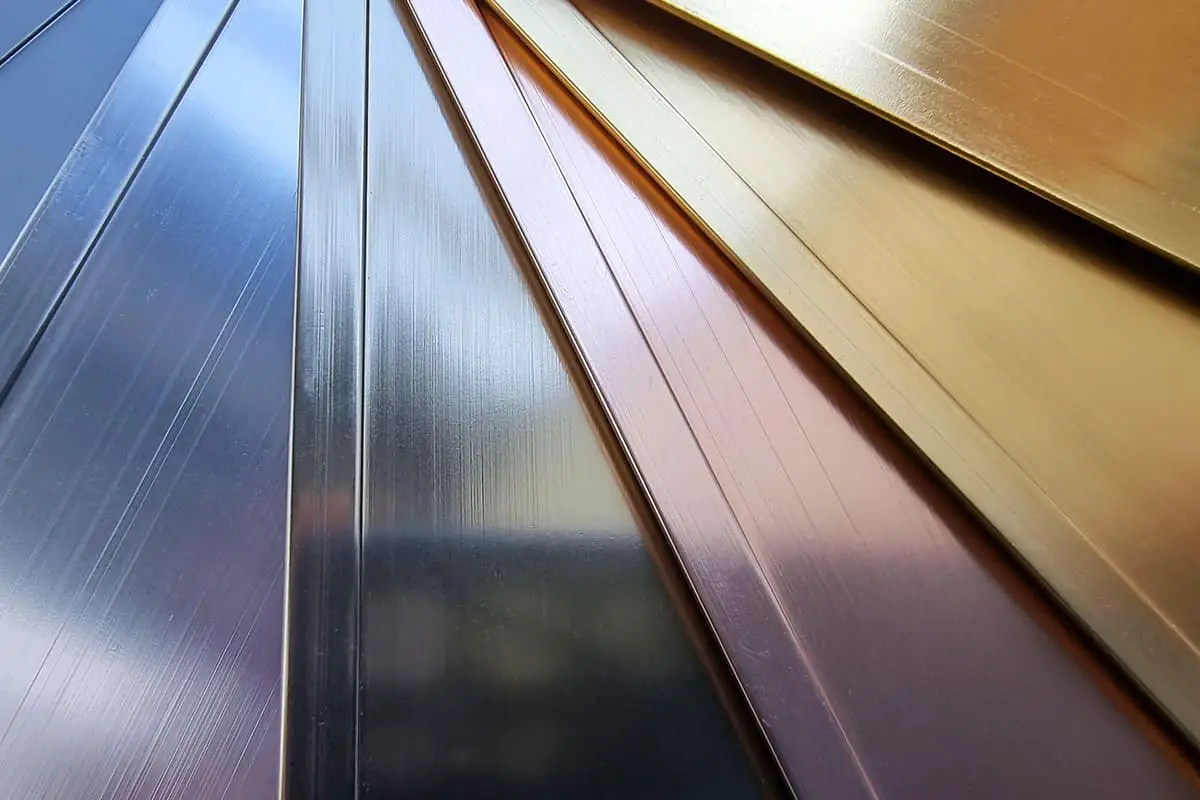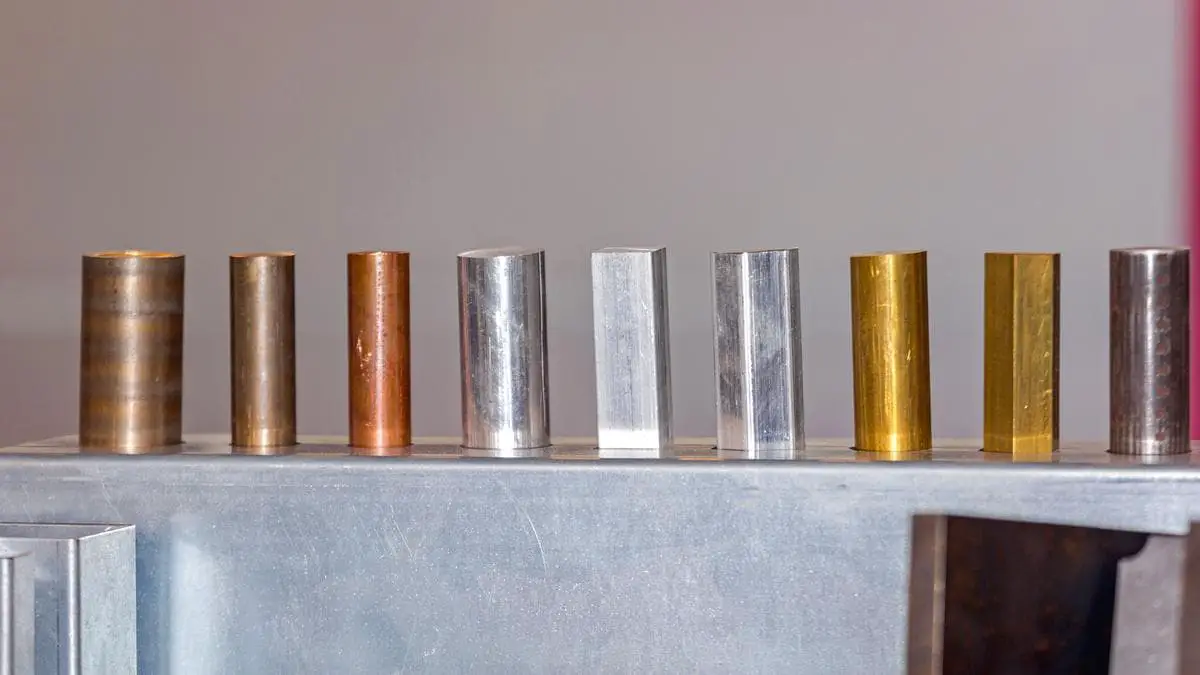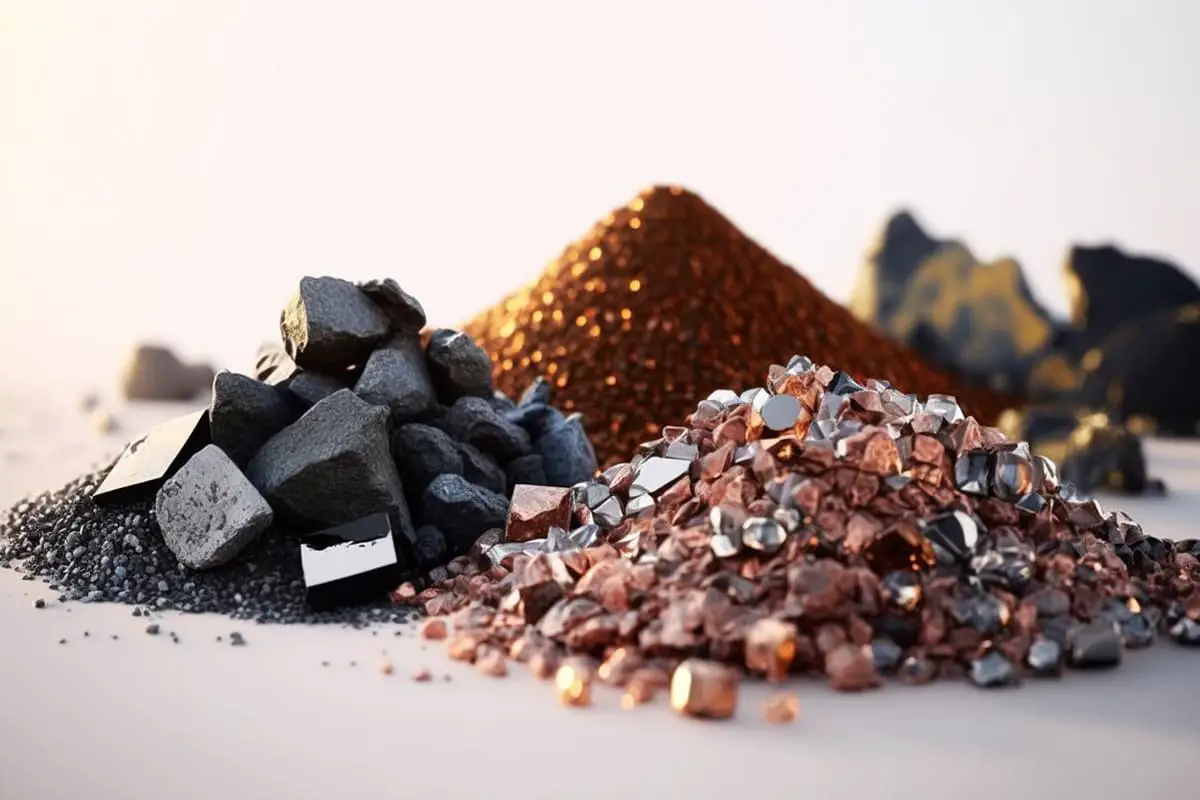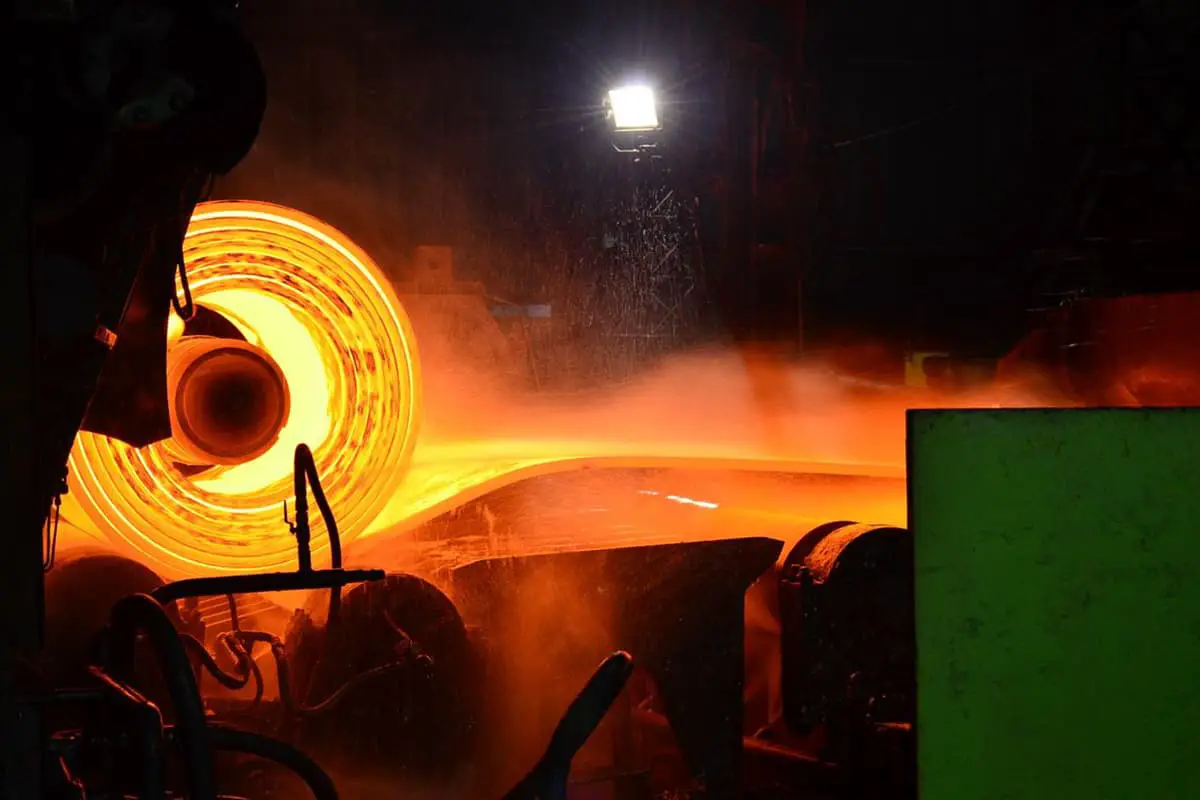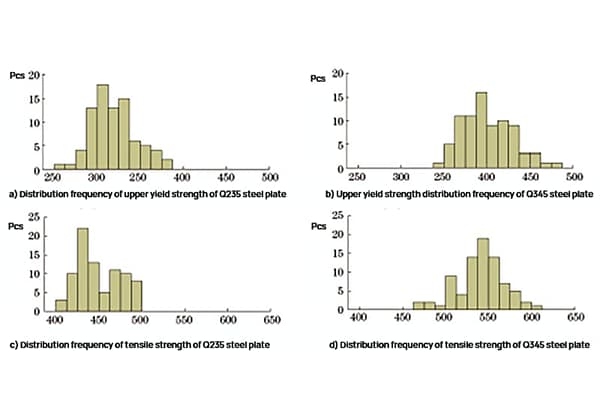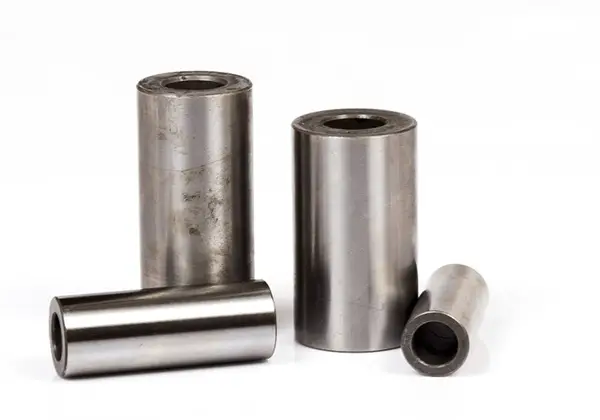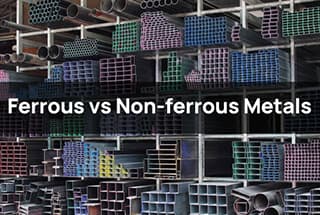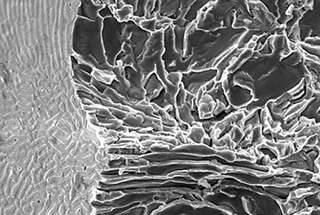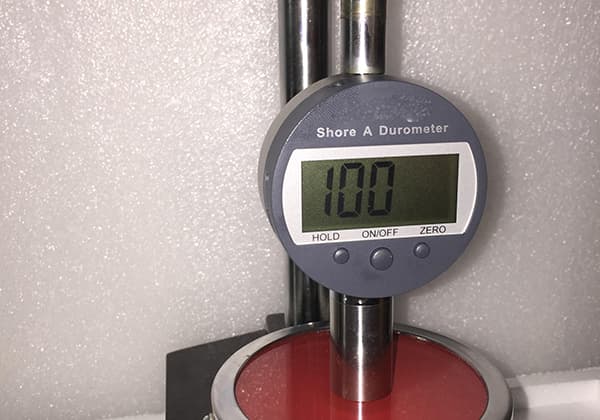
Have you ever wondered about the fascinating world of metal hardness? In this blog post, we’ll dive into the intriguing concepts and methods behind measuring and enhancing the hardness of various metals. As an experienced mechanical engineer, I’ll share my insights and knowledge to help you better understand this crucial aspect of material science. Get ready to uncover the secrets of metal hardness and discover how it impacts our everyday lives!
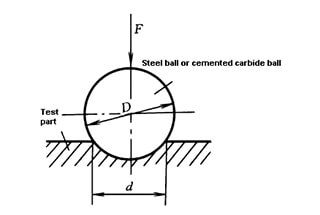
The hardness of a metal refers to its ability to resist local deformation, particularly plastic deformation, indentations, or scratches. It’s a measure of the material’s softness or hardness.
There are two main types of metal hardness testing methods: static and dynamic. Static testing methods include Brinell, Rockwell, Vickers, Knoop, Meyer, and Barcol, with Brinell, Rockwell, and Vickers being the most widely used. Dynamic testing methods involve the dynamic and impactful application of test forces.
The measurement of hardness is primarily determined by the depth of the indentation, the projected area of the indentation, or the size of the indentation imprint. For instance, Brinell hardness (HB) is calculated by pressing a certain diameter of hardened steel or hard alloy ball into the tested metal surface under a certain test load, maintaining it for a specified time, then unloading, and measuring the diameter of the indentation on the tested surface.
There are numerous methods to increase metal hardness, including alloying with hard elements in the material, process hardening, grain refinement strengthening, dispersion strengthening, second phase strengthening, heat treatment strengthening (such as quenching, carburizing, nitriding, metal infiltration), and surface strengthening. Additionally, the wear resistance of metal materials can be improved by changing the structural form and altering the crystalline state.
The Mohs hardness is a standard for representing mineral hardness, first proposed in 1822 by German mineralogist Frederich Mohs. It is a standard used in mineralogy or gemology. Mohs hardness is determined by using a diamond pyramid needle to scratch the surface of the tested mineral and measure the depth of the scratch. The depth of this scratch is the Mohs hardness, represented by the symbol HM. It is also used to indicate the hardness of other materials.
The depth of the measured scratch is divided into ten levels to represent hardness (scratch method): talc 1 (smallest hardness), gypsum 2, calcite 3, fluorite 4, apatite 5, orthoclase (feldspar) 6, quartz 7, topaz 8, corundum 9, diamond 10. The hardness of the tested mineral is determined by comparing scratches with the standard minerals in the Mohs hardness tester. Although the measurement of this method is rough, it is convenient and practical. It is often used to measure the hardness of natural minerals.
Hardness values are not absolute hardness values, but values represented in order of hardness.
When applying, compare the hardness by scratching. For example, if a mineral can scratch calcite but not fluorite, its Mohs hardness is 3 to 4, and others are inferred. Mohs hardness is only relative hardness, which is rough. The hardness of talc is 1, diamond is 10, and corundum is 9, but the absolute hardness measured by a microhardness tester is 4192 times that of talc for diamond, and 442 times that of talc for corundum. Mohs hardness is convenient to use and is often used in field operations. For example, the hardness of fingernails is about 2.5, copper coins are 3.5-4, steel knives are 5.5, and glass is 6.5.
In addition to the original list of 1 to 10 kinds of minerals, the hardness values of common metals are listed here for reference.
| Metal | Element | Hardness (Mohs) |
| Carbon(diamond) | C | 10 |
| Boron | B | 9.3 |
| Titanium Carbide | Ti+C | 9 |
| Tungsten Carbide | W+C | 9 |
| Chromium | Cr | 8.5 |
| Tungsten | W | 7.5 |
| Vanadium | V | 7 |
| Rhenium | Re | 7 |
| Osmium | Os | 7 |
| Silicon | Si | 6.5 |
| Ruthenium | Ru | 6.5 |
| Tantalum | Ta | 6.5 |
| Iridium | Ir | 6.5 |
| Titanium | Ti | 6 |
| Manganese | Mn | 6 |
| Germanium | Ge | 6 |
| Niobium | Nb | 6 |
| Rhodium | Rh | 6 |
| Uranium | U | 6 |
| Beryllium | Be | 6 |
| Molybdenum | Mo | 5.5 |
| Hafnium | Hf | 5.5 |
| Cobalt | Co | 5 |
| Zirconium | Zr | 5 |
| Palladium | Pd | 4.75 |
| White Gold | Au+Ni+Pd | 4 |
| Steel | Fe+C | 4 |
| Iron | Fe | 4 |
| Nickel | Ni | 4 |
| Arsenic | As | 3.5 |
| Platinum | Pt | 3.5 |
| Brass | Cu+Zn | 3 |
| Bronze | Cu+Sn | 3 |
| Copper | Cu | 3 |
| Antimony | Sb | 3 |
| Thorium | Th | 3 |
| Aluminum | Al | 2.75 |
| Magnesium | Mg | 2.5 |
| Zinc | Zn | 2.5 |
| Silver | Ag | 2.5 |
| Lanthanum | La | 2.5 |
| Cerium | Ce | 2.5 |
| Gold | Au | 2.5 |
| Tellurium | Te | 2.25 |
| Bismuth | Bi | 2.25 |
| Cadmium | Cd | 2 |
| Calcium | Ca | 1.75 |
| Gallium | Ga | 1.5 |
| Strontium | Sr | 1.5 |
| Tin | Sn | 1.5 |
| Mercury | Hg | 1.5 |
| Lead | Pb | 1.5 |
| Barium | Ba | 1.25 |
| Indium | In | 1.2 |
| Thallium | Ti | 1.2 |
| Lithium | Li | 1.2 |
| Sodium | Na | 0.5 |
| Potassium | K | 0.4 |
| Rubidium | Rb | 0.3 |
| Caesium | Cs | 0.2 |
| No. | Material Code | Strength Grade | Hardness Value(HB) |
| 01 | 1Cr13 | 440(45) | 197~229 |
| 355 | 187~229 | ||
| 02 | 1Cr12Mo | 550 | 229~255 |
| 450 | 197~229 | ||
| 03 | Cr11MoV | 490(50) | 217~248 |
| 390 | 192~241 | ||
| 590 | 235~269 | ||
| 04 | Cr12WMoV | 590 | 235~269 |
| 690 | 269~302 | ||
| 05 | 2Cr12NiMoWV | 760 | 293~331 |
| 06 | ZG20CrMoV | 310 | 140~201 |
| 07 | 25Cr2MoVA | 590 | 241~277 |
| 735 | 269~302 | ||
| 08 | 30Cr2MoV | 440 | 179~229 |
| 590 | 241~277 | ||
| 735 | 269~302 | ||
| 09 | 38CrMoAl | 590 | 241~277 |
| 685 | 277~302 | ||
| 785 | 293~321 | ||
| 10 | A3 | Hardness after Nitriding Component Normalizing | <131 |
| 11 | 15# | <143 | |
| 12 | 25# | <170 | |
| 13 | ZG25 | <170 | |
| 14 | 20CrA | <179 | |
| 15 | 12CrNi3A | <252 | |
| 16 | 2Cr13 | 490 | 217~248 |
| 590 | 235~269 | ||
| 17 | 2Cr12NiW1Mo1V | 735 | 285~302 |
| 18 | 0Cr17Ni4Cu4Nb | 590 | 262~302 |
| 760 | 277~311 | ||
| 19 | Cr5Mo | / | 248~302 |
| 20 | GH132(GBn181-82) | / | 284~349 |
| 21 | GH136(GBn181-82) | / | 298~390 |
| 22 | R-26 | 550 | 262~331 |
| 23 | 3Cr13 | 590 | 235~269 |
| 685 | 269~302 | ||
| 23 | 3Cr13 | 785 | 286~321 |
| 24 | 1Cr18Ni9Ti | 205(225) | ≦187 |
| 25 | 0Cr18Ni9 | 205 | ≦187 |
| 26 | 1Cr18Ni9 | 205 | ≦187 |
| 27 | Cr15Ni3Bw3Ti | 390 | 207~255 |
| 28 | 34CrMo1A | 490(590) | / |
| 29 | 30Cr2MoV | 590 | 241~277 |
| 690 | 256~287 | ||
| 735 | 269~302 | ||
| 30 | 34CrNi3Mo | 590 | 220~260 |
| 690 | 240~282 | ||
| 735 | 255~284 | ||
| 785 | 271~298 | ||
| 31 | 30Cr2Ni4MoV | 550 | 207~262 |
| 690 | 241~302 | ||
| 760 | 262~321 | ||
| 830 | 285~341 | ||
| 32 | 15CrMoA | 245 | 131~163 |
| 490 | 207~241 | ||
| 33 | 15Cr1Mo | 275 | ≦207 |
| 34 | 12Cr1MoVA | 245 | 131~163 |
| 35 | 12Cr2Mo1 | 275 | ≦197 |
| 315 | ≦207 | ||
| 36 | 15Cr1Mo1VA | 325 | 146~196 |
| 37 | 25# | 235(215) | 110~170 |
| 38 | 30# | 265 | ≦187 |
| 39 | 35# | 265 | 156~217 |
| 255 | 140~187 | ||
| 235 | 121~187 | ||
| 40 | 45# | 295 | 162~217 |
| 285 | 149~217 | ||
| 440 | 197~229 | ||
| 345 | 217~255 | ||
| 41 | 15CrMoA | 245 | 131~163 |
| 490 | 207~241 | ||
| 42 | 20MnMo | 350 | 149~217 |
| 43 | 40CrNi3MoA | 550 | 207~262 |
| 690 | 241~302 | ||
| 44 | 15CrMoA | 490 | 207~241 |
| 45 | 40CrA | 390 | 192~223 |
| 45 | 40CrA | 490 | 217~235 |
| 590 | 241~277 | ||
| 685 | 269~302 | ||
| 46 | 40CrNi2MoA | 540 | 207~269 |
| 640 | 248~277 | ||
| 785 | 269~321 | ||
| 47 | 35CrMoA | 490 | 217~255 |
| 590 | 241~277 | ||
| 48 | 40CrNiMoA | 690 | 255~293 |
| 49 | 20Cr1Mo1VtiB | 690 | 255~293 |
| 50 | 30Cr1Mo1V | 590 | 241~277 |
| 51 | 30Cr1Mo1V | 690 | 255~285 |
| Materials | Reference Standards and Requirements(HB) | Control Scope(HB) | Note |
| 210C | ASTM A210,≤179 | 130~179 | |
| T1a, 20MoG, STBA12, 15Mo3 | ASTM A209,≤153 | 125~153 | |
| T2, T11, T12, T21, T22, 10CrMo910 | ASTM A213,≤163 | 120~163 | |
| P2, P11, P12, /P21, P22, 10CrMo910 | 125~179 | ||
| P2, P11, P12, /P21P22, 10CrMo910 type pipe fittings | 130~197 | The lower limit of the weld seam must not be less than that of the base material,upper limit≤241 | |
| T23 | ASTM A213,≤220 | 150~220 | |
| 12Cr2MoWVTiB(G102) | 150~220 | ||
| T24 | ASTM A213,≤250 | 180~250 | |
| T/P91, T/P92, T911, T/P122 | ASTM A213,≤250ASTM A335,≤250 | 180~250 | The hardness of “P” type pipes refers to that of “T” type pipes. |
| (T/P91, T/P92, T911, T/P122)Weld Seam | 180~270 | ||
| WB36 | ASME code case2353,≤252 | 180~252 | The weld seam must not be less hard than the base material. |
| A515, A106B, A106C, A672 B70 type pipe fittings | 130~197 | The lower limit of the weld seam must not be less than the base material, with the upper limit≤241. | |
| 12CrMo | GB3077,≤179 | 120~179 | |
| 15CrMo | JB4726,118~180(Rm:440~610)JB4726,115~178(Rm:430~600) | 118~180115~178 | |
| 12Cr1MoV | GB3077,≤179 | 135~179 | |
| 15Cr1Mo1V | 135~180 | ||
| F2(Forged or Rolled Pipe Fittings, Valves, and Components) | ASTM A182,143~192 | 143~192 | |
| F11,Class 1 | ASTM A182,121~174 | 121~174 | |
| F11,Class 2 | ASTM A182,143~207 | 143~207 | |
| F11,Class 3 | ASTM A182,156~207 | 156~207 | |
| F12,Class 1 | ASTM A182,121~174 | 121~174 | |
| F12,Class 2 | ASTM A182,143~207 | 143~207 | |
| F22,Class 1 | ASTM A182, ≤170 | 130~170 | |
| F22,Class 3 | ASTM A182,156~207 | 156~207 | |
| F91 | ASTM A182, ≤248 | 175~248 | |
| F92 | ASTM A182, ≤269 | 180~269 | |
| F911 | ASTM A182, 187~248 | 187~248 | |
| F122 | ASTM A182, ≤250 | 177~250 | |
| 20 Pressure Vessel Carbon Steel and Low Alloy Steel Forgings | JB4726,106~159 | 106~159 | |
| 35 (Note: The Rm in the table refers to the tensile strength of the material, measured in MPa.) | JB4726,136~200(Rm:510~670)JB4726,130~190(Rm:490~640) | 136~200130~190 | |
| 16Mn | JB4726,121~178(Rm:450~600) | 121~178 | |
| 20MnMo | JB4726,156~208(Rm:530~700)JB4726,136~201(Rm:510~680)JB4726,130~196(Rm:490~660) | 156~208136~201130~196 | |
| 35CrMo | JB4726,185~235(Rm:620~790)JB4726,180~223(Rm:610~780) | 185~235180~223 | |
| 0Cr18Ni90Cr17Ni12Mo2 | JB4728,139~187(Rm:520)JB4728,131~187(Rm:490) | 139~187131~187 | Stainless Steel Forgings for Pressure Vessels |
| 1Cr18Ni9 | GB1220 ≤187 | 140~187 | |
| 0Cr17Ni12Mo2 | GB1220 ≤187 | 140~187 | |
| 0Cr18Ni11Nb | GB1220 ≤187 | 140~187 | |
| TP304H, TP316H, TP347H | ASTM A213,≤192 | 140~192 | |
| 1Cr13 | 192~211 | Moving Blades | |
| 2Cr13 | 212~277 | Moving Blades | |
| 1Cr11MoV | 212~277 | Moving Blades | |
| 1Cr12MoWV | 229~311 | Moving Blades | |
| ZG20CrMo | JB/T 7024,135~180 | 135~180 | |
| ZG15Cr1Mo | JB/T 7024,140~220 | 140~220 | |
| ZG15Cr2Mo1 | JB/T 7024,140~220 | 140~220 | |
| ZG20CrMoV | JB/T 7024,140~220 | 140~220 | |
| ZG15Cr1Mo1V | JB/T 7024,140~220 | 140~220 | |
| 35 | DL/T439,146~196 | 146~196 | Bolt |
| 45 | DL/T439,187~229 | 187~229 | Bolt |
| 20CrMo | DL/T439,197~241 | 197~241 | Bolt |
| 35CrMo | DL/T439,241~285 | 241~285 | Bolt(Dia.>50mm) |
| 35CrMo | DL/T439,255~311 | 255~311 | Bolt(Dia.≤50mm) |
| 42CrMo | DL/T439,248~311 | 248~311 | Bolt(Dia.>65mm) |
| 42CrMo | DL/T439,255~321 | 255~321 | Bolt(Dia.≤65mm) |
| 25Cr2MoV | DL/T439,248~293 | 248~293 | Bolt |
| 25Cr2Mo1V | DL/T439,248~293 | 248~293 | Bolt |
| 20Cr1Mo1V1 | DL/T439,248~293 | 248~293 | Bolt |
| 20Cr1Mo1VTiB | DL/T439,255~293 | 255~293 | Bolt |
| 20Cr1Mo1VNbTiB | DL/T439,252~302 | 252~302 | Bolt |
| 20Cr12NiMoWV(C422) | DL/T439,277~331 | 277~331 | Bolt |
| 2Cr12NiW1Mo1V | Eastern Steam Turbine Factory Standard | 291~321 | Bolt |
| 2Cr11Mo1NiWVNbN | Eastern Steam Turbine Factory Standard | 290~321 | Bolt |
| 45Cr1MoV | Eastern Steam Turbine Factory Standard | 248~293 | Bolt |
| R-26(Ni-Cr-Co Alloy) | DL/T439,262~331 | 262~331 | Bolt |
| GH445 | DL/T439,262~331 | 262~331 | Bolt |
| ZG20CrMo | JB/T7024,135~180 | 135~180 | Cylinder |
| ZG15Cr1Mo, ZG15Cr2MoZG20Cr1MoV, ZG15Cr1Mo1V | JB/T7024,140~220 | 140~220 | Cylinder |
| Non-ferrous Metal Hardness | Tensile strength δb/MPa | |||||||||||||||
|---|---|---|---|---|---|---|---|---|---|---|---|---|---|---|---|---|
| Rockwell | Surface Rockwell | Vickers | Brinell (F/D2=30) | |||||||||||||
| HRC | HRA | HR15N | HR30N | HR45N | HV | HBS | HBW | MS | Cr.S | Cr-V.S | CrNi.S | Cr-Mo.S | Cr-Ni-Mo .S | CrMnSi.S | UHSS | S.S |
| 20.0 | 60.2 | 68.8 | 40.7 | 19.2 | 226 | 225 | 225 | 774 | 742 | 736 | 782 | 747 | / | 781 | / | 740 |
| 20.5 | 60.4 | 69.0 | 41.2 | 19.8 | 228 | 227 | 227 | 784 | 751 | 744 | 787 | 753 | / | 788 | / | 749 |
| 21.0 | 60.7 | 69.3 | 41.7 | 20.4 | 230 | 229 | 229 | 793 | 760 | 753 | 792 | 760 | / | 794 | / | 758 |
| 21.5 | 61.0 | 69.5 | 42.2 | 21.0 | 233 | 232 | 232 | 803 | 769 | 761 | 797 | 767 | / | 801 | / | 767 |
| 22.0 | 61.2 | 69.8 | 42.6 | 21.5 | 235 | 234 | 234 | 813 | 779 | 770 | 803 | 774 | / | 809 | / | 777 |
| 22.5 | 61.5 | 70.0 | 43.1 | 22.1 | 238 | 237 | 237 | 823 | 788 | 779 | 809 | 781 | / | 816 | / | 786 |
| 23.0 | 61.7 | 70.3 | 43.6 | 22.7 | 24l | 240 | 240 | 833 | 798 | 788 | 815 | 789 | / | 824 | / | 796 |
| 23.5 | 62.0 | 70.6 | 44.0 | 23.3 | 244 | 242 | 242 | 843 | 808 | 797 | 822 | 797 | / | 832 | / | 806 |
| 24.0 | 62.2 | 70.8 | 44.5 | 23.9 | 247 | 245 | 245 | 854 | 818 | 807 | 829 | 805 | / | 840 | / | 816 |
| 24.5 | 62.5 | 71.1 | 45.0 | 24.5 | 250 | 248 | 248 | 864 | 828 | 816 | 836 | 813 | / | 848 | / | 826 |
| 25.0 | 62.8 | 71.4 | 45.5 | 25.1 | 253 | 251 | 251 | 875 | 838 | 826 | 843 | 822 | / | 856 | / | 837 |
| 25.5 | 63.0 | 71.6 | 45.9 | 25.7 | 256 | 254 | 254 | 886 | 848 | 837 | 851 | 831 | 850 | 865 | / | 847 |
| 26.0 | 63.3 | 71.9 | 46.4 | 26.3 | 259 | 257 | 257 | 897 | 859 | 847 | 859 | 840 | 859 | 874 | / | 858 |
| 26.5 | 63.5 | 72.2 | 46.9 | 26.9 | 262 | 260 | 260 | 908 | 870 | 858 | 867 | 850 | 869 | 883 | / | 868 |
| 27.0 | 63.8 | 72.4 | 47.3 | 27.5 | 266 | 263 | 263 | 919 | 880 | 869 | 876 | 860 | 879 | 893 | / | 879 |
| 27.5 | 64.0 | 72.7 | 47.8 | 28.1 | 269 | 266 | 266 | 930 | 891 | 880 | 885 | 870 | 890 | 902 | / | 890 |
| 28.0 | 64.3 | 73.0 | 48.3 | 28.7 | 273 | 269 | 269 | 942 | 902 | 892 | 894 | 880 | 901 | 912 | / | 901 |
| 28.5 | 64.6 | 73.3 | 48.7 | 29.3 | 276 | 273 | 273 | 954 | 914 | 903 | 904 | 891 | 912 | 922 | / | 913 |
| 29.0 | 64.8 | 73.5 | 49.2 | 29.9 | 280 | 276 | 276 | 965 | 925 | 915 | 914 | 902 | 923 | 933 | / | 924 |
| 29.5 | 65.1 | 73.8 | 49.7 | 30.5 | 284 | 280 | 280 | 977 | 937 | 928 | 924 | 913 | 935 | 943 | / | 936 |
| 30.0 | 65.3 | 74.1 | 50.2 | 31.1 | 288 | 283 | 283 | 989 | 948 | 940 | 935 | 924 | 947 | 954 | / | 947 |
| 30.5 | 65.6 | 74.4 | 50.6 | 31.7 | 292 | 287 | 287 | 1002 | 960 | 953 | 946 | 936 | 959 | 965 | / | 959 |
| 31.0 | 65.8 | 74.7 | 51.1 | 32.3 | 296 | 29l | 29l | 1014 | 972 | 966 | 957 | 948 | 972 | 977 | / | 971 |
| 31.5 | 66.1 | 74.9 | 51.6 | 32.9 | 300 | 294 | 294 | 1027 | 984 | 980 | 969 | 961 | 985 | 989 | / | 983 |
| 32.0 | 66.4 | 75.2 | 52.0 | 33.5 | 304 | 298 | 298 | 1039 | 996 | 993 | 981 | 974 | 999 | 1001 | / | 996 |
| 32.5 | 66.6 | 75.5 | 52.5 | 34.1 | 308 | 302 | 302 | 1052 | 1009 | 1007 | 994 | 987 | 1012 | 1013 | / | 1008 |
| 33.0 | 66.9 | 75.8 | 53.0 | 34.7 | 313 | 306 | 306 | 1065 | 1022 | 1022 | 1007 | 1001 | 1027 | 1026 | / | 1021 |
| 33.5 | 67.1 | 76.1 | 53.4 | 35.3 | 317 | 310 | 310 | 1078 | 1034 | 1036 | 1020 | 1015 | 1041 | 1039 | / | 1034 |
| 34.0 | 67.4 | 76.4 | 53.9 | 35.9 | 32l | 314 | 314 | 1092 | 1048 | 1051 | 1034 | 1029 | 1056 | 1052 | / | 1047 |
| 34.5 | 67.7 | 76.7 | 54.4 | 36.5 | 326 | 318 | 318 | 1105 | 1061 | 1067 | 1048 | 1043 | 1071 | 1066 | / | 1060 |
| 35.0 | 67.9 | 77.0 | 54.8 | 37.0 | 33l | 323 | 323 | 1119 | 1074 | 1082 | 1063 | 1058 | 1087 | 1079 | / | 1074 |
| 35.5 | 68.2 | 77.2 | 55.3 | 37.6 | 335 | 327 | 327 | 1133 | 1088 | 1098 | 1078 | 1074 | 1103 | 1094 | / | 1087 |
| 36.0 | 68.4 | 77.5 | 55.8 | 38.2 | 340 | 332 | 332 | 1147 | 1102 | 1114 | 1093 | 1090 | 1119 | 1108 | / | 1101 |
| 36.5 | 68.7 | 77.8 | 56.2 | 38.8 | 345 | 336 | 336 | 1162 | 1116 | 1131 | 1109 | 1106 | 1136 | 1123 | / | 1116 |
| 37.0 | 69.0 | 78.1 | 56.7 | 39.4 | 350 | 341 | 341 | 1177 | 1131 | 1148 | 1125 | 1122 | 1153 | 1139 | / | 1130 |
| 37.5 | 69.2 | 78.4 | 57.2 | 40.0 | 355 | 345 | 345 | 1192 | 1146 | 1165 | 1142 | 1139 | 1171 | 1155 | / | 1145 |
| 38.0 | 69.5 | 78.7 | 57.6 | 40.6 | 360 | 350 | 350 | 1207 | 1161 | 1183 | 1159 | 1157 | 1189 | 1171 | / | 1161 |
| 38.5 | 69.7 | 79.0 | 58.1 | 41.2 | 365 | 355 | 355 | 1222 | 1176 | 1201 | 1177 | 1174 | 1207 | 1187 | 1170 | 1176 |
| 39.0 | 70.0 | 79.3 | 58.6 | 41.8 | 37l | 360 | 360 | 1238 | 1192 | 1219 | 1195 | 1192 | 1226 | 1204 | 1195 | 1193 |
| 39.5 | 70.3 | 79.6 | 59.0 | 42.4 | 376 | 365 | 365 | 1254 | 1208 | 1238 | 1214 | 1211 | 1245 | 1222 | 1219 | 1209 |
| 40.0 | 70.5 | 79.9 | 59.5 | 43.0 | 381 | 370 | 370 | 1271 | 1225 | 1257 | 1233 | 1230 | 1265 | 1240 | 1243 | 1226 |
| 40.5 | 70.8 | 80.2 | 60.0 | 43.6 | 387 | 375 | 375 | 1288 | 1242 | 1276 | 1252 | 1249 | 1285 | 1258 | 1267 | 1244 |
| 41.0 | 71.1 | 80.5 | 60.4 | 44.2 | 393 | 380 | 381 | 1305 | 1260 | 1296 | 1273 | 1269 | 1306 | 1277 | 1290 | 1262 |
| 41.5 | 71.3 | 80.8 | 60.9 | 44.8 | 398 | 385 | 386 | 1322 | 1278 | 1317 | 1293 | 1289 | 1327 | 1296 | 1313 | 1280 |
| 42.0 | 71.6 | 81.1 | 61.3 | 45.4 | 404 | 39l | 392 | 1340 | 1296 | 1337 | 1314 | 1310 | 1348 | 1316 | 1336 | 1299 |
| 42.5 | 71.8 | 81.4 | 61.8 | 45.9 | 410 | 396 | 397 | 1359 | 1315 | 1358 | 1336 | 1331 | 1370 | 1336 | 1359 | 1319 |
| 43.0 | 72.1 | 81.7 | 62.3 | 46.5 | 416 | 40l | 403 | 1378 | 1335 | 1380 | 1358 | 1353 | 1392 | 1357 | 1381 | 1339 |
| 43.5 | 72.4 | 82.0 | 62.7 | 47.1 | 422 | 407 | 409 | 1397 | 1355 | 1401 | 1380 | 1375 | 1415 | 1378 | 1404 | 1361 |
| 44.0 | 72.6 | 82.3 | 63.2 | 47.7 | 428 | 413 | 415 | 1417 | 1376 | 1424 | 1404 | 1397 | 1439 | 1400 | 1427 | 1383 |
| 44.5 | 72.9 | 82.6 | 63.6 | 48.3 | 435 | 418 | 422 | 1438 | 1398 | 1446 | 1427 | 1420 | 1462 | 1422 | 1450 | 1405 |
| 45.0 | 73.2 | 82.9 | 64.1 | 48.9 | 44l | 424 | 428 | 1459 | 1420 | 1469 | 1451 | 1444 | 1487 | 1445 | 1473 | 1429 |
| 45.5 | 73.4 | 83.2 | 64.6 | 49.5 | 448 | 430 | 435 | 1481 | 1444 | 1493 | 1476 | 1468 | 1512 | 1469 | 1496 | 1453 |
| 46.0 | 73.7 | 83.5 | 65.0 | 50.1 | 454 | 436 | 44l | 1503 | 1468 | 1517 | 1502 | 1492 | 1537 | 1493 | 1520 | 1479 |
| 46.5 | 73.9 | 83.7 | 65.5 | 50.7 | 46l | 442 | 448 | 1526 | 1493 | 1541 | 1527 | 1517 | 1563 | 1517 | 1544 | 1505 |
| 47.0 | 74.2 | 84.0 | 65.9 | 51.2 | 468 | 449 | 455 | 1550 | 1519 | 1566 | 1554 | 1542 | 1589 | 1543 | 1569 | 1533 |
| 47.5 | 74.5 | 84.3 | 66.4 | 51.8 | 475 | / | 463 | 1575 | 1546 | 1591 | 1581 | 1568 | 1616 | 1569 | 1594 | 1562 |
| 48.0 | 74.7 | 84.6 | 66.8 | 52.4 | 482 | / | 470 | 1600 | 1574 | 1617 | 1608 | 1595 | 1643 | 1595 | 1620 | 1592 |
| 48.5 | 75.0 | 84.9 | 67.3 | 53.0 | 489 | / | 478 | 1626 | 1603 | 1643 | 1636 | 1622 | 1671 | 1623 | 1646 | 1623 |
| 49.0 | 75.3 | 85.2 | 67.7 | 53.6 | 497 | / | 486 | 1653 | 1633 | 1670 | 1665 | 1649 | 1699 | 1651 | 1674 | 1655 |
| 49.5 | 75.5 | 85.5 | 68.2 | 54.2 | 504 | / | 494 | 1681 | 1665 | 1697 | 1695 | 1677 | 1728 | 1679 | 1702 | 1689 |
| 50.0 | 75.8 | 85.7 | 68.6 | 54.7 | 512 | 502 | 502 | 1710 | 1698 | 1724 | 1724 | 1706 | 1758 | 1709 | 1731 | 1725 |
| 50.5 | 76.1 | 86.0 | 69.1 | 55.3 | 520 | 510 | 510 | / | 1732 | 1752 | 1755 | 1735 | 1788 | 1739 | 1761 | / |
| 51.0 | 76.3 | 86.3 | 69.5 | 55.9 | 527 | 518 | 518 | / | 1768 | 1780 | 1786 | 1764 | 1819 | 1770 | 1792 | / |
| 51.5 | 76.6 | 86.6 | 70.0 | 56.5 | 535 | 527 | 527 | / | 1806 | 1809 | 1818 | 1794 | 1850 | 1801 | 1824 | / |
| 52.0 | 76.9 | 86.8 | 70.4 | 57.1 | 544 | 535 | 535 | / | 1845 | 1839 | 1850 | 1825 | 1881 | 1834 | 1857 | / |
| 52.5 | 77.1 | 87.1 | 70.9 | 57.6 | 552 | 544 | 544 | / | / | 1869 | 1883 | 1856 | 1914 | 1867 | 1892 | / |
| 53.0 | 77.4 | 87.4 | 71.3 | 58.2 | 561 | 552 | 552 | / | / | 1899 | 1917 | 1888 | 1947 | 1901 | 1929 | / |
| 53.5 | 77.7 | 87.6 | 71.8 | 58.8 | 569 | 56l | 56l | / | / | 1930 | 1951 | / | / | 1936 | 1966 | / |
| 54.0 | 77.9 | 87.9 | 72.2 | 59.4 | 578 | 569 | 569 | / | / | 1961 | 1986 | / | / | 1971 | 2006 | / |
| 54.5 | 78.2 | 88.1 | 72.6 | 59.9 | 587 | 577 | 577 | / | / | 1993 | 2022 | / | / | 2008 | 2047 | / |
| 55.0 | 78.5 | 88.4 | 73.1 | 60.5 | 596 | 585 | 585 | / | / | 2026 | 2058 | / | / | 2045 | 2090 | / |
| 55.5 | 78.7 | 88.6 | 73.5 | 61.1 | 606 | 593 | 593 | / | / | / | / | / | / | / | 2135 | / |
| 56.0 | 79.0 | 88.9 | 73.9 | 61.7 | 615 | 601 | 601 | / | / | / | / | / | / | / | 2181 | / |
| 56.5 | 79.3 | 89.1 | 74.4 | 62.2 | 625 | 608 | 608 | / | / | / | / | / | / | / | 2230 | / |
| 57.0 | 79.5 | 89.4 | 74.8 | 62.8 | 635 | 616 | 616 | / | / | / | / | / | / | / | 2281 | / |
| 57.5 | 79.8 | 89,6 | 75.2 | 63.4 | 645 | 622 | 622 | / | / | / | / | / | / | / | 2334 | / |
| 58.0 | 80.1 | 89.8 | 75.6 | 63.9 | 655 | 628 | 628 | / | / | / | / | / | / | / | 2390 | / |
| 58.5 | 80.3 | 90.0 | 76.1 | 64.5 | 666 | 634 | 634 | / | / | / | / | / | / | / | 2448 | / |
| 59.0 | 80.6 | 90.2 | 76.5 | 65.1 | 676 | 639 | 639 | / | / | / | / | / | / | / | 2509 | / |
| 59.5 | 80.9 | 90.4 | 76.9 | 65.6 | 687 | 643 | 643 | / | / | / | / | / | / | / | 2572 | / |
| 60.0 | 81.2 | 90.6 | 77.3 | 66.2 | 698 | 647 | 647 | / | / | / | / | / | / | / | / | / |
| 60.5 | 81.4 | 90.8 | 77.7 | 66.8 | 710 | 650 | 650 | / | / | / | / | / | / | / | / | / |
| 61.0 | 81.7 | 91.0 | 78.1 | 67.3 | 72l | / | / | / | / | / | / | / | / | / | / | / |
| 61.5 | 82.0 | 91.2 | 78.6 | 67.9 | 733 | / | / | / | / | / | / | / | / | / | / | / |
| 62.0 | 82.2 | 91.4 | 79.0 | 68.4 | 745 | / | / | / | / | / | / | / | / | / | / | / |
| 62.5 | 82.5 | 91.5 | 79.4 | 69.0 | 757 | / | / | / | / | / | / | / | / | / | / | / |
| 63.0 | 82.8 | 91.7 | 79.8 | 69.5 | 770 | / | / | / | / | / | / | / | / | / | / | / |
| 63.5 | 83.1 | 91.8 | 80.2 | 70.1 | 782 | / | / | / | / | / | / | / | / | / | / | / |
| 64.0 | 83.3 | 91.9 | 80.6 | 70.6 | 795 | / | / | / | / | / | / | / | / | / | / | / |
| 64.5 | 83.6 | 92.1 | 81.0 | 71.2 | 809 | / | / | / | / | / | / | / | / | / | / | / |
| 65.0 | 83.9 | 92.2 | 81.3 | 71.1 | 822 | / | / | / | / | / | / | / | / | / | / | / |
| 65.5 | 84.1 | / | / | / | 836 | / | / | / | / | / | / | / | / | / | / | / |
| 66.0 | 84.4 | / | / | / | 850 | / | / | / | / | / | / | / | / | / | / | / |
| 66.5 | 84.7 | / | / | / | 865 | / | / | / | / | / | / | / | / | / | / | / |
| 67.0 | 85.0 | / | / | / | 879 | / | / | / | / | / | / | / | / | / | / | / |
| 67.5 | 85.2 | / | / | / | 894 | / | / | / | / | / | / | / | / | / | / | / |
| 68.0 | 85.5 | / | / | / | 909 | / | / | / | / | / | / | / | / | / | / | / |
The following data is mainly applicable to low-carbon steel (mild steel).
| Ferrous Metal Hardness | Tensile strength | ||||||
|---|---|---|---|---|---|---|---|
| Rockwell | Surface Rockwell | Vickers | Brinell HBS | ||||
| HRB | HR15T | HR30T | HR45T | HV | F/D2=10 | F/D2=10 | MPa |
| 60.0 | 80.4 | 56.1 | 30.4 | 105 | 102 | / | 375 |
| 60.5 | 80.5 | 56.4 | 30.9 | 105 | 102 | / | 377 |
| 61.0 | 80.7 | 56.7 | 31.4 | 106 | 103 | / | 379 |
| 61.5 | 80.8 | 57.1 | 31.9 | 107 | 103 | / | 381 |
| 62.0 | 80.9 | 57.4 | 32.4 | 108 | 104 | / | 382 |
| 62.5 | 81.1 | 57.7 | 32.9 | 108 | 104 | / | 384 |
| 63.0 | 81.2 | 58.0 | 33.5 | 109 | 105 | / | 386 |
| 63.5 | 81.4 | 58.3 | 34.0 | 110 | 105 | / | 388 |
| 64.0 | 81.5 | 58.7 | 34.5 | 110 | 106 | / | 390 |
| 64.5 | 81.6 | 59.0 | 35.0 | 11l | 106 | / | 393 |
| 65.0 | 81.8 | 59.3 | 35.5 | 112 | 107 | / | 395 |
| 65.5 | 81.9 | 59.6 | 36.1 | 113 | 107 | / | 397 |
| 66.0 | 82.1 | 59.9 | 36.6 | 114 | 108 | / | 399 |
| 66.5 | 82.2 | 60.3 | 37.1 | 115 | 108 | / | 402 |
| 67.0 | 82.3 | 60.6 | 37.6 | 115 | 109 | / | 404 |
| 67.5 | 82.5 | 60.9 | 38.1 | 116 | 110 | / | 407 |
| 68.0 | 82.6 | 61.2 | 38.6 | 117 | 110 | / | 409 |
| 68.5 | 82.7 | 61.5 | 39.2 | 118 | 111 | / | 412 |
| 69.0 | 82.9 | 61.9 | 39.7 | 119 | 112 | / | 415 |
| 69.5 | 83.0 | 62.2 | 40.2 | 120 | 112 | / | 418 |
| 70.0 | 83.2 | 62.5 | 40.7 | 12l | 113 | / | 42l |
| 70.5 | 83.3 | 62.8 | 41.2 | 122 | 114 | / | 424 |
| 71.0 | 83.4 | 63.1 | 41.7 | 123 | 115 | / | 427 |
| 71.5 | 83.6 | 63.5 | 42.3 | 124 | 115 | / | 430 |
| 72.0 | 83.7 | 63.8 | 42.8 | 125 | 116 | / | 433 |
| 72.5 | 83.9 | 64.1 | 43.3 | 126 | 117 | / | 437 |
| 73.0 | 84.0 | 64.4 | 43.8 | 128 | 118 | / | 440 |
| 73.5 | 84.1 | 64.7 | 44.3 | 129 | 119 | / | 444 |
| 74.0 | 84.3 | 65.1 | 44.8 | 130 | 120 | / | 447 |
| 74.5 | 84.4 | 65.4 | 45.4 | 13l | 12l | / | 451 |
| 75.0 | 84.5 | 65.7 | 45.9 | 132 | 122 | 152 | 455 |
| 75.5 | 84.7 | 66.0 | 46.4 | 134 | 123 | 155 | 459 |
| 76.0 | 84.8 | 66.3 | 46.9 | 135 | 124 | 156 | 463 |
| 76.5 | 85.0 | 66.6 | 47.4 | 136 | 125 | 158 | 467 |
| 77.0 | 85.1 | 67.0 | 47.9 | 138 | 126 | 159 | 471 |
| 77.5 | 85.2 | 67.3 | 48.5 | 139 | 127 | 16l | 475 |
| 78.0 | 85.4 | 67.6 | 49.0 | 140 | 128 | 163 | 480 |
| 78.5 | 85.5 | 67.9 | 49.5 | 142 | 129 | 164 | 484 |
| 79.0 | 85.7 | 68.2 | 50.0 | 143 | 130 | 166 | 489 |
| 79.5 | 85.8 | 68.6 | 50.5 | 145 | 132 | 168 | 493 |
| 80.0 | 85.9 | 68.9 | 51.0 | 146 | 133 | 170 | 498 |
| 80.5 | 86.1 | 69.2 | 51.6 | 148 | 134 | 172 | 503 |
| 81.0 | 86.2 | 69.5 | 52.1 | 149 | 136 | 174 | 508 |
| 81.5 | 86.3 | 69.8 | 52.6 | 151 | 137 | / | 513 |
| 82.0 | 86.5 | 70.2 | 53.1 | 152 | 138 | / | 518 |
| 82.5 | 86.6 | 70.5 | 53.6 | 154 | 140 | / | 523 |
| 83.0 | 86.8 | 70.8 | 54.1 | 156 | / | / | 529 |
| 83.5 | 86.9 | 71.1 | 54.7 | 157 | / | / | 534 |
| 84.0 | 87.0 | 71.4 | 55.2 | 159 | / | / | 540 |
| 84.5 | 87.2 | 71.8 | 55.7 | 16l | / | / | 546 |
| 85.0 | 87.3 | 72.1 | 56.2 | 163 | / | / | 551 |
| 85.5 | 87.5 | 72.4 | 56.7 | 165 | / | / | 557 |
| 86.0 | 87.6 | 72.7 | 57.2 | 166 | / | / | 563 |
| 86.5 | 87.7 | 73.0 | 57.8 | 168 | / | / | 570 |
| 87.0 | 87.9 | 73.4 | 58.3 | 170 | / | / | 576 |
| 87.5 | 88.0 | 73.7 | 58.8 | 172 | / | / | 582 |
| 88.0 | 88.1 | 74.0 | 59.3 | 174 | / | / | 589 |
| 88.5 | 88.3 | 74.3 | 59.8 | 176 | / | / | 596 |
| 89.0 | 88.4 | 74.6 | 60.3 | 178 | / | / | 603 |
| 89.5 | 88.6 | 75.0 | 60.9 | 180 | / | / | 609 |
| 90.0 | 88.7 | 75.3 | 61.4 | 183 | / | 176 | 617 |
| 90.5 | 88.8 | 75.6 | 61.9 | 185 | / | 178 | 624 |
| 91.0 | 89.0 | 75.9 | 62.4 | 187 | / | 180 | 63l |
| 91.5 | 89.1 | 76.2 | 62.9 | 189 | / | 182 | 639 |
| 92.0 | 89.3 | 76.6 | 63.4 | 191 | / | 184 | 646 |
| 92.5 | 89.4 | 76.9 | 64.0 | 194 | / | 187 | 654 |
| 93.0 | 89.5 | 77.2 | 64.5 | 196 | / | 189 | 662 |
| 93.5 | 89.7 | 77.5 | 65.0 | 199 | / | 192 | 670 |
| 94.0 | 89.8 | 77.8 | 65.5 | 201 | / | 195 | 678 |
| 94.5 | 89.9 | 78.2 | 66.0 | 203 | / | 197 | 686 |
| 95.5 | 90.1 | 78.5 | 66.5 | 206 | / | 200 | 695 |
| 95.0 | 90.2 | 78.8 | 67.1 | 208 | / | 203 | 703 |
| 96.0 | 90.4 | 79.1 | 67.6 | 211 | / | 206 | 712 |
| 96.5 | 90.5 | 79.4 | 68.1 | 214 | / | 209 | 721 |
| 97.0 | 90.6 | 79.8 | 68.6 | 216 | / | 212 | 730 |
| 97.5 | 90.8 | 80.1 | 69.1 | 219 | / | 215 | 739 |
| 98.0 | 90.9 | 80.4 | 69.6 | 222 | / | 218 | 749 |
| 98.5 | 91.1 | 80.7 | 70.2 | 225 | / | 222 | 758 |
| 99.0 | 91.2 | 81.0 | 70.7 | 227 | / | 226 | 768 |
| 99.5 | 91.3 | 81.4 | 71.2 | 230 | / | 229 | 778 |
| 100.0 | 91.5 | 81.7 | 71.7 | 233 | / | 232 | 788 |
Related reading: Metal Hardness Comparison Chart: HV, HB, HRC
The Brinell hardness test uses a ball made of hardened steel or a hard alloy with a diameter of D as the indenter.
A specified test force F is applied to the surface of the material being tested, and after a designated hold time, the test force is removed, leaving an indentation with a diameter of d.
The Brinell hardness value is calculated by dividing the test force by the surface area of the indentation. The symbol for the Brinell hardness value is represented as HBS or HBW.
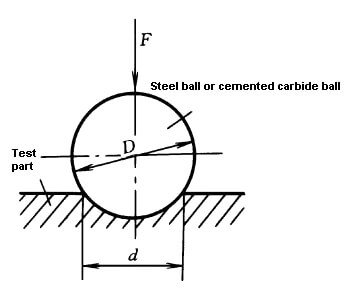
The difference between HBS and HBW lies in the type of indenter used.
HBS indicates the use of a hardened steel ball as the indenter and is used to determine the Brinell hardness of materials with a value less than 450, such as mild steel, gray cast iron, and non-ferrous metals.
HBW, on the other hand, refers to the use of a hard alloy ball as the indenter and is used to measure the Brinell hardness of materials with a value below 650.
Even when the same material and experimental conditions are used, the results of the two tests may vary, with the HBW value typically being higher than the HBS value, and there is no exact quantitative rule to follow.

In 2003, China adopted international standards and discontinued the use of steel ball indenters in favor of hard alloy ball heads.
As a result, HBS was no longer used and all Brinell hardness values are now represented by HBW.
Although HBW is often simply referred to as HB, references to HBS may still be found in literature.
The Brinell hardness measurement method is suitable for testing materials such as cast iron, non-ferrous alloys, and various steels that have undergone annealing or quenching and tempering processes.
However, it is not suitable for testing samples or workpieces that are too hard, too small, too thin, or do not allow for large indentations on the surface.
The Vickers hardness test uses either a diamond cone with a 120-degree cone apex angle or a hardened steel ball with a diameter of Ø1.588mm or Ø3.176mm as the indenter, along with a specified load.
The sample is subjected to an initial load of 10kgf and a total load of 60, 100, or 150kgf.
After the total load is applied, the hardness is determined by the difference in indentation depth when the main load is removed while retaining the initial load and the indentation depth under the initial load.
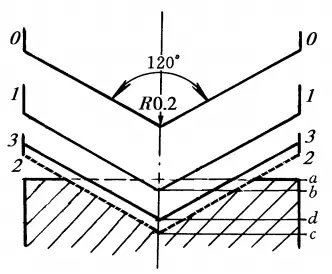
The Rockwell hardness test uses three different test forces and three different indenters, resulting in a total of nine possible combinations and corresponding Rockwell hardness scales.
These nine scales are suitable for a wide range of commonly used metal materials.
The three most commonly used Rockwell hardness scales are HRA, HRB, and HRC, with HRC being the most widely utilized.
Table of commonly used Rockwell hardness test specifications
| Hardness symbol | Indenter type | Total test force F/N(kgf) | Hardness range | Applications |
|---|---|---|---|---|
| HRA | 120°diamond cone | 588.4(60) | 20~88 | Hard alloy, carbide, shallow case hardening steel and etc. |
| HRB | Ø1.588mm Quenched steel ball | 980.7(100) | 20~100 | Annealed or normalized steel, aluminum alloy, copper alloy, cast iron |
| HRC | 120°diamond cone | 1471(150) | 20~70 | Hardened steel, quenched and tempered steel, deep case hardening steel |
The Rockwell hardness test is appropriate for hardness values ranging from 20-70HRC. If the hardness of the sample is less than 20HRC, it is recommended to use the HRB scale as the sensitivity of the indenter decreases with increased pressure on the conical part.
However, if the hardness of the sample is greater than 67HRC, it is advised to use the HRA scale as the pressure on the tip of the indenter may become too high and result in damage to the diamond and reduced life of the indenter.
The Rockwell hardness test is known for its ease, speed, and minimal indentation, making it ideal for testing the surface of finished products and harder, thinner workpieces.
However, due to the small indentation, the hardness value may fluctuate greatly for materials with uneven structures and hardness, making it less accurate than the Brinell hardness test.
The Rockwell hardness test is commonly used to determine the hardness of materials such as steel, non-ferrous metals, and cemented carbides.
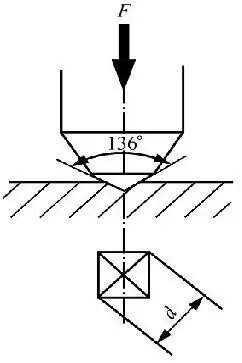
The principle behind the Vickers hardness measurement is similar to that of the Brinell hardness test.
A diamond pyramid-shaped indenter with an angle of 136° is used to apply a specified test force, F, onto the surface of the material being tested.
After a specified holding time, the test force is removed, and the hardness value is calculated as the average pressure on the unit surface area of the regular pyramid-shaped indentation, with the symbol HV.

The Vickers hardness measurement has a wide range, and it can measure materials with a hardness ranging from 10 to 1000 HV. The indentation is small in size.
This measurement method is commonly used to measure thin materials and surface-hardened layers created through carburizing and nitriding.
The Leeb Hardness Test uses a device equipped with a tungsten carbide ball to impact the surface of the test piece, which then rebounds. The speed of the rebound is affected by the hardness of the material being tested.
A permanent magnetic material is installed on the impact device, which produces an electromagnetic signal proportional to the speed of the impact body’s movement. This signal is then converted into a Leeb hardness value by an electronic circuit, represented by the symbol HL.
The Leeb Hardness Tester is a handheld device that does not require a workbench. Its hardness sensor is compact and can be easily operated by hand, making it suitable for testing large, heavy, or complex geometries.
One of the key benefits of the Leeb Hardness Test is that it results in only light surface damage, making it an ideal option for non-destructive testing. It also provides a unique hardness test for all directions, narrow spaces, and special parts.
The Brinell hardness test measures the hardness of a sample by pressing a steel ball or diamond cone into the sample’s surface and measuring the depth of the indentation. This method is suitable for determining the hardness of materials such as annealed, normalized, quenched and tempered steel, cast iron, and non-ferrous metals.
The Rockwell hardness test uses specific procedures and smaller indenters, such as diamonds, to measure hardness, making it suitable for a wide range of materials.
The Vickers hardness test retains the advantages of both the Brinell and Rockwell tests, capable of measuring materials ranging from extremely soft to extremely hard, and their results can be compared.
The specifics of the advantages and disadvantages of the Knoop hardness test are not detailed in the information I found, but it is one of the static test methods, on par with Brinell, Rockwell, and Vickers.
The Webster hardness tester is primarily used to check the mechanical properties of aluminum alloy profiles, but it’s also suitable for materials like copper, brass, and mild steel.
The Barcol hardness tester is a type of indentation hardness tester. The specifics of its advantages and disadvantages are not explicitly stated in the information I found.
Each hardness testing method has its characteristics and range of applications:
HM series:
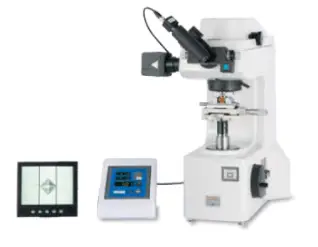
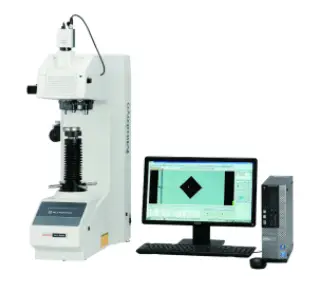
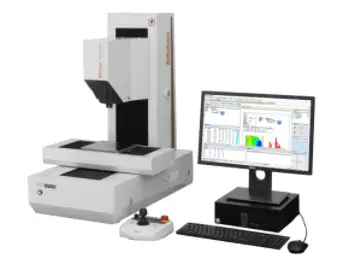
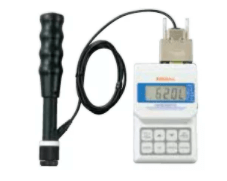
The hardness of metal materials can be enhanced through heat treatment using several methods, including:
Carburizing and Nitriding: These chemical heat treatment methods involve the infusion of carbon atoms (carburizing) or active nitrogen atoms (nitriding) into the surface layer of the metal. This increases the carbon content or abrasion resistance of the metal surface layer, thus enhancing hardness and wear resistance. Commonly used carburizing medium is charcoal, while nitriding utilizes active nitrogen atoms decomposed from ammonia gas when heated.
Quenching: For general medium carbon steel and high carbon steel, the hardness can be improved through quenching. Quenching is a common heat treatment method that involves heating the steel to an appropriate temperature and then cooling it quickly to achieve higher hardness.
Altering Grain Size and Phase Composition: Heat treatment affects hardness by altering the grain size and phase composition of the metal material. This can be achieved through mechanisms such as grain boundary solution strengthening, crystal solution strengthening, and phase transformation strengthening.
Coating Technology: Using coating technology during the heat treatment process of metal materials can prevent significant damage to the metal structure while achieving optimal hardness, ensuring a significant improvement in application results.
Reorganizing the Organizational Structure: Heat treatment processing can enhance material uniformity and hardness by reorganizing the organizational structure and reducing or eliminating non-uniformity. This method can be implemented in various ways depending on specific needs.
Forming a Protective Layer: Forming a thin protective layer on the surface of metal materials alters the original structure of the metal. Compared to traditional quenching methods, this approach effectively increases the surface hardness of the metal and offers the advantage of easy operation.

